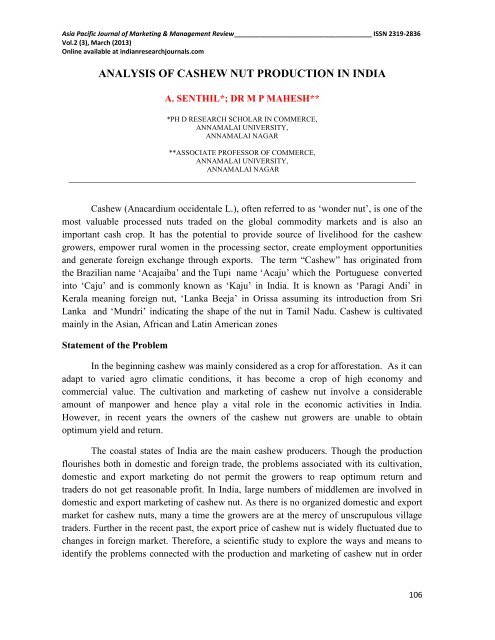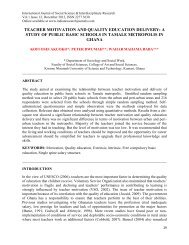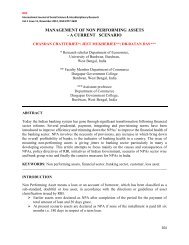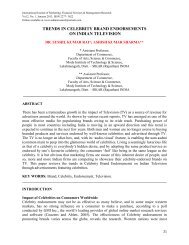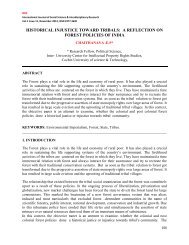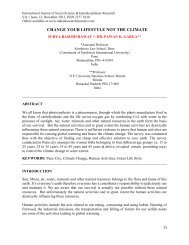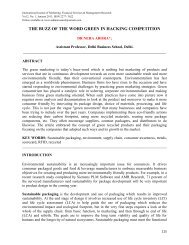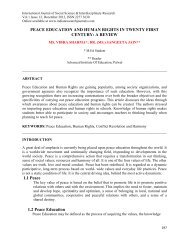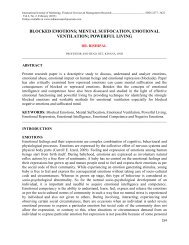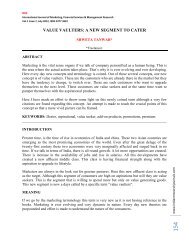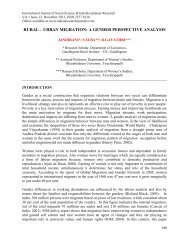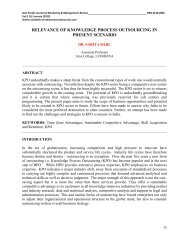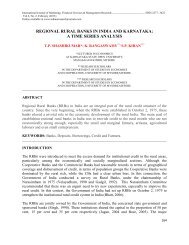analysis of cashew nut production in india - Indianresearchjournals ...
analysis of cashew nut production in india - Indianresearchjournals ...
analysis of cashew nut production in india - Indianresearchjournals ...
Create successful ePaper yourself
Turn your PDF publications into a flip-book with our unique Google optimized e-Paper software.
Asia Pacific Journal <strong>of</strong> Market<strong>in</strong>g & Management Review______________________________________ ISSN 2319-2836<br />
Vol.2 (3), March (2013)<br />
Onl<strong>in</strong>e available at <strong>in</strong>dianresearchjournals.com<br />
ANALYSIS OF CASHEW NUT PRODUCTION IN INDIA<br />
A. SENTHIL*; DR M P MAHESH**<br />
*PH D RESEARCH SCHOLAR IN COMMERCE,<br />
ANNAMALAI UNIVERSITY,<br />
ANNAMALAI NAGAR<br />
**ASSOCIATE PROFESSOR OF COMMERCE,<br />
ANNAMALAI UNIVERSITY,<br />
ANNAMALAI NAGAR<br />
______________________________________________________________________________<br />
Cashew (Anacardium occidentale L.), <strong>of</strong>ten referred to as „wonder <strong>nut</strong>‟, is one <strong>of</strong> the<br />
most valuable processed <strong>nut</strong>s traded on the global commodity markets and is also an<br />
important cash crop. It has the potential to provide source <strong>of</strong> livelihood for the <strong>cashew</strong><br />
growers, empower rural women <strong>in</strong> the process<strong>in</strong>g sector, create employment opportunities<br />
and generate foreign exchange through exports. The term “Cashew” has orig<strong>in</strong>ated from<br />
the Brazilian name „Acajaiba‟ and the Tupi name „Acaju‟ which the Portuguese converted<br />
<strong>in</strong>to „Caju‟ and is commonly known as „Kaju‟ <strong>in</strong> India. It is known as „Paragi Andi‟ <strong>in</strong><br />
Kerala mean<strong>in</strong>g foreign <strong>nut</strong>, „Lanka Beeja‟ <strong>in</strong> Orissa assum<strong>in</strong>g its <strong>in</strong>troduction from Sri<br />
Lanka and „Mundri‟ <strong>in</strong>dicat<strong>in</strong>g the shape <strong>of</strong> the <strong>nut</strong> <strong>in</strong> Tamil Nadu. Cashew is cultivated<br />
ma<strong>in</strong>ly <strong>in</strong> the Asian, African and Lat<strong>in</strong> American zones<br />
Statement <strong>of</strong> the Problem<br />
In the beg<strong>in</strong>n<strong>in</strong>g <strong>cashew</strong> was ma<strong>in</strong>ly considered as a crop for afforestation. As it can<br />
adapt to varied agro climatic conditions, it has become a crop <strong>of</strong> high economy and<br />
commercial value. The cultivation and market<strong>in</strong>g <strong>of</strong> <strong>cashew</strong> <strong>nut</strong> <strong>in</strong>volve a considerable<br />
amount <strong>of</strong> manpower and hence play a vital role <strong>in</strong> the economic activities <strong>in</strong> India.<br />
However, <strong>in</strong> recent years the owners <strong>of</strong> the <strong>cashew</strong> <strong>nut</strong> growers are unable to obta<strong>in</strong><br />
optimum yield and return.<br />
The coastal states <strong>of</strong> India are the ma<strong>in</strong> <strong>cashew</strong> producers. Though the <strong>production</strong><br />
flourishes both <strong>in</strong> domestic and foreign trade, the problems associated with its cultivation,<br />
domestic and export market<strong>in</strong>g do not permit the growers to reap optimum return and<br />
traders do not get reasonable pr<strong>of</strong>it. In India, large numbers <strong>of</strong> middlemen are <strong>in</strong>volved <strong>in</strong><br />
domestic and export market<strong>in</strong>g <strong>of</strong> <strong>cashew</strong> <strong>nut</strong>. As there is no organized domestic and export<br />
market for <strong>cashew</strong> <strong>nut</strong>s, many a time the growers are at the mercy <strong>of</strong> unscrupulous village<br />
traders. Further <strong>in</strong> the recent past, the export price <strong>of</strong> <strong>cashew</strong> <strong>nut</strong> is widely fluctuated due to<br />
changes <strong>in</strong> foreign market. Therefore, a scientific study to explore the ways and means to<br />
identify the problems connected with the <strong>production</strong> and market<strong>in</strong>g <strong>of</strong> <strong>cashew</strong> <strong>nut</strong> <strong>in</strong> order<br />
106
Asia Pacific Journal <strong>of</strong> Market<strong>in</strong>g & Management Review______________________________________ ISSN 2319-2836<br />
Vol.2 (3), March (2013)<br />
Onl<strong>in</strong>e available at <strong>in</strong>dianresearchjournals.com<br />
to enlighten the people concerned about the <strong>in</strong>herent strength, weakness, opportunity and<br />
threat becomes relevant and socially significant.<br />
The ma<strong>in</strong> objective <strong>of</strong> the article is to highlight the growth and performance <strong>of</strong><br />
<strong>cashew</strong> <strong>nut</strong> <strong>production</strong> <strong>in</strong> the various states <strong>in</strong> India dur<strong>in</strong>g 1990-91 to 2009 -10. The<br />
secondary data were collected from the Directorate <strong>of</strong> Cashew and Cocoa Development,<br />
Cashew Export Promotion Council, Cashew Research Stations, Agricultural Department,<br />
Forest Department, District Industrial Centre, Directorate <strong>of</strong> Horticulture, Directorate <strong>of</strong><br />
Economics and Statistics and Directorate <strong>of</strong> Agricultural Market<strong>in</strong>g.<br />
Cashew Nut Production<br />
India is the largest producer <strong>of</strong> <strong>cashew</strong> <strong>nut</strong> <strong>in</strong> the world as well as <strong>in</strong> Asia account<strong>in</strong>g<br />
39.47 per cent <strong>of</strong> world <strong>cashew</strong> <strong>production</strong> <strong>in</strong> 2010. It has the largest area harvested under<br />
the raw <strong>cashew</strong> <strong>nut</strong>s <strong>in</strong> the world. it is an important plantation crop <strong>in</strong> wasteland<br />
development programme due to its utility <strong>in</strong> soil conservation and to buildup <strong>of</strong> balanced<br />
ecosystem. The major <strong>cashew</strong> <strong>nut</strong> produc<strong>in</strong>g states <strong>in</strong> India are Maharastra, Kerala, Andhra<br />
Pradesh, Orissa, Karnataka, Tamil Nadu, Goa and West Bengal. The <strong>cashew</strong> <strong>nut</strong> <strong>production</strong><br />
<strong>of</strong> major produc<strong>in</strong>g states <strong>in</strong> India from 1990-91 to 2009-10 is shown <strong>in</strong> Table 1.<br />
It is seen from the table, that there was an <strong>in</strong>creas<strong>in</strong>g trend <strong>in</strong> the <strong>production</strong> <strong>of</strong><br />
<strong>cashew</strong> <strong>nut</strong> throughout the study period. The annual <strong>production</strong> <strong>of</strong> <strong>cashew</strong> <strong>nut</strong> varied<br />
throughout the study and the variation ranged from -16.27 per cent to 14.37 per cent. As per<br />
the F.A.O statistics, 21.6 per cent <strong>of</strong> the world harvested area under <strong>cashew</strong> <strong>nut</strong> was <strong>in</strong> India<br />
and the country accounted for 17.3 per cent <strong>of</strong> the total world <strong>cashew</strong> <strong>nut</strong> <strong>production</strong> dur<strong>in</strong>g<br />
the year 2009-10.<br />
Maharastra is the lead<strong>in</strong>g <strong>cashew</strong> <strong>nut</strong> producer <strong>in</strong> India. It has an average <strong>of</strong><br />
111334.4 metric tonnes per annum. It alone has registered a gradual <strong>in</strong>creas<strong>in</strong>g trend dur<strong>in</strong>g<br />
the study period except the years 1997-98, 2000-01 and 2009-10. The reasons beh<strong>in</strong>ds are<br />
pest and disease problems <strong>in</strong> <strong>cashew</strong> cultivation and due to water stress<br />
107
Asia Pacific Journal <strong>of</strong> Market<strong>in</strong>g & Management Review______________________________________ ISSN 2319-2836<br />
Vol.2 (3), March (2013)<br />
Onl<strong>in</strong>e available at <strong>in</strong>dianresearchjournals.com<br />
TABLE 1<br />
Cashew Nut Production <strong>in</strong> the Major Produc<strong>in</strong>g States <strong>in</strong> India dur<strong>in</strong>g 1990 to 2010. (Qty <strong>in</strong> Mt)<br />
Year<br />
Maharas<br />
tra<br />
Kerala<br />
Andhra<br />
Pradesh<br />
Orissa<br />
Karna<br />
taka<br />
Tamil<br />
Nadu<br />
Goa<br />
West<br />
Bengal<br />
Others<br />
Total<br />
Increas<br />
e\Decre<br />
ase<br />
% <strong>of</strong><br />
Increase\<br />
Decrease<br />
1991 29519 142100 33770 29100 25770 12470 14100 3440 320 294590<br />
1992 31960 143200 40360 31840 26750 12710 14490 3660 340 305310 10720 3.63<br />
1993 43750 151600 44850 39060 31260 19190 15450 3660 340 349190 43880 14.37<br />
1994 46860 140200 46570 43420 31540 19200 16210 3990 360 348350 -840 -0.24<br />
1995 37600 119200 58700 37200 26400 22000 16960 3280 300 321640 -26710 -7.66<br />
1996 69000 140000 71600 43000 37600 30930 17100 6960 840 417830 96190 29.90<br />
1997 80000 134000 60000 50000 52000 30000 20000 6000 8000 430000 12170 2.91<br />
1998 60000 100000 50000 45000 35000 30000 25000 6000 9000 360000 -70000 -16.27<br />
1999 85000 130000 80000 50000 40000 35000 20000 8000 12000 460000 100000 27.77<br />
2000 125000 100000 100000 40000 60000 45000 30000 8000 12000 520000 60000 13.04<br />
2001 98000 76000 75000 59000 42000 59000 25000 6000 10000 450000 -70000 -13.46<br />
2002 103000 87000 86000 59000 40000 46000 30000 7000 12000 470000 20000 4.44<br />
2003 110000 90000 90000 70000 40000 50000 30000 8000 12000 500000 30000 6.38<br />
2004 120000 95000 95000 71000 46000 51000 32000 9000 18000 535000 35000 7.00<br />
2005 174000 64000 88000 74000 43000 53000 26000 8800 14000 544000 9000 1.68<br />
2006 183000 67000 92000 78000 45000 56000 27000 10000 15000 573000 29000 5.33<br />
2007 197000 72000 99000 84000 52000 60000 29000 10000 17000 620000 47000 8.20<br />
2008 210000 78000 107000 90000 56000 65000 31000 10000 18000 665000 45000 7.25<br />
2009 225000 75000 112000 95000 60000 68000 30000 11000 19000 695000 30000 4.51<br />
2010 198000 66000 99000 84000 53000 60000 26000 10000 17000 613000 -82000 -11.79<br />
TOTA<br />
L<br />
2226689<br />
2070300<br />
1528850 1172620 843320 824500 475310 142790<br />
195500<br />
9471910<br />
AVG 111334.4<br />
103515<br />
76442.5 58631 42166 41225 23765.5 7139.5<br />
9775<br />
473595.<br />
5<br />
RANK I II III IV V VI VII VIII<br />
PER<br />
23.50<br />
16.14 12.37 8.90 8.70 5.01 1.50<br />
100.00<br />
CENT<br />
21.85<br />
2.06<br />
CGR 11.40 4.700 5.40 6.00 11.60 8.90 4.30 6.50 28.00 4.30<br />
108
Asia Pacific Journal <strong>of</strong> Market<strong>in</strong>g & Management Review______________________________________ ISSN 2319-2836<br />
Vol.2 (3), March (2013)<br />
Onl<strong>in</strong>e available at <strong>in</strong>dianresearchjournals.com<br />
Source: The Cashew Export Promotion Council, Coch<strong>in</strong>.<br />
dur<strong>in</strong>g flower<strong>in</strong>g and fruit<strong>in</strong>g. 1 It contributes 23.50 per cent <strong>of</strong> India‟s <strong>production</strong>. The<br />
compound growth rate reveals that the Maharastra occupies the first place followed by Orissa,<br />
Andhra Pradesh and Kerala. The Compound Growth Rate is 11.40 per cent per annum.<br />
Kerala is the second largest <strong>cashew</strong> <strong>nut</strong> producer <strong>in</strong> India. It has also an <strong>in</strong>creas<strong>in</strong>g trend<br />
dur<strong>in</strong>g the study period except the years 1993-94 to 1994-95, 1996-97 to 1997-98, 2000-01,<br />
2004-05, 2008-09 and 2009-10. Its contribution is 21.85 per cent <strong>of</strong> India‟s <strong>production</strong>. The<br />
reason beh<strong>in</strong>ds are fell<strong>in</strong>g <strong>of</strong> <strong>cashew</strong> trees, conservation <strong>of</strong> <strong>cashew</strong> area <strong>in</strong>to rubber plantations,<br />
ris<strong>in</strong>g <strong>in</strong> prices and conservation <strong>cashew</strong> <strong>in</strong>to turmeric <strong>in</strong> small patches. Recurr<strong>in</strong>g cost <strong>in</strong> kerala<br />
was high due to high labour cost. The Compound Growth Rate is 4.70 per cent per annum.<br />
Andhra Pradesh has an average <strong>of</strong> 76442.5 metric tonnes dur<strong>in</strong>g the study period. It has<br />
an <strong>in</strong>creas<strong>in</strong>g trend <strong>in</strong> <strong>cashew</strong> <strong>nut</strong> <strong>production</strong>. There was a decreas<strong>in</strong>g <strong>in</strong> trend <strong>production</strong> due to<br />
plantations have been established with clonal material <strong>of</strong> high yield<strong>in</strong>g varieties 2 . Its contribution<br />
to India‟s <strong>production</strong> is 16.14 per cent per annum. The Compound Growth Rate is 5.40 per cent<br />
per annum.<br />
Orissa has an average <strong>production</strong> <strong>of</strong> 58631 metric tonnes <strong>in</strong> the study period. It has<br />
<strong>in</strong>creas<strong>in</strong>g trend <strong>of</strong> <strong>cashew</strong> <strong>nut</strong> <strong>production</strong>s throughout the period. But, there was also decreas<strong>in</strong>g<br />
trend noticed <strong>in</strong> the years 1994-95, 1997-98, 1999-2000 and 2009-2010. The reason beh<strong>in</strong>ds are<br />
pest and disease improper utilization manures and fertilizer, mildew and cyclones, deforestation<br />
and farmers switch over to commercial crops like jute and sugarcane. Its contribution to India‟s<br />
<strong>production</strong> is 12.37 per cent per annum and Compound Growth Rate is 6.00 per cent per annum.<br />
Karnataka has an average <strong>of</strong> 42166 metric tonnes <strong>of</strong> <strong>cashew</strong> <strong>nut</strong> <strong>production</strong>s over the<br />
period. It has an <strong>in</strong>creas<strong>in</strong>g trend <strong>in</strong> <strong>cashew</strong> <strong>nut</strong> <strong>production</strong>. But, unfortunately there was<br />
decreas<strong>in</strong>g trend identified <strong>in</strong> the years 1994-95, 1997-98, 2000-01, 2004-05, and 2009-10. Its<br />
contribution to India‟s <strong>production</strong> is 8.90 per cent per annum. The reasons beh<strong>in</strong>d are high cost<br />
<strong>of</strong> grafter/air layer, lack <strong>of</strong> plant <strong>production</strong> chemicals and establishment cost was relatively<br />
higher than other crops. The Compound Growth Rate is 11.60 per cent per annum.<br />
Tamil Nadu is the six largest producer state <strong>of</strong> <strong>cashew</strong> <strong>nut</strong> <strong>in</strong> India. It has an average <strong>of</strong><br />
41225 metric tonnes dur<strong>in</strong>g the study period. Production has an <strong>in</strong>creas<strong>in</strong>g trend except the years<br />
2001-02 and 2009-10. The reasons beh<strong>in</strong>d are replantation, deforestation, ra<strong>in</strong>fall and<br />
temperature which are also the two major factors contribut<strong>in</strong>g <strong>cashew</strong> <strong>production</strong>. Cloudy<br />
weather dur<strong>in</strong>g flower<strong>in</strong>g sometimes is beneficial, but heavy ra<strong>in</strong>s dur<strong>in</strong>g flower<strong>in</strong>g and fruit<br />
1 Haldankar, P.M. “ Strategies and Constra<strong>in</strong>ts for Cashew Production <strong>in</strong> Maharastra”, The Cashew, 18(8), p14.<br />
2004.<br />
2 Venkattakumar R.,“ Socio Economic Factors for Cashew Production and Implicative Strategies: An Over View,”<br />
Indian Res.J. Ext. Edu. 9(3) September , (2009)<br />
109
Asia Pacific Journal <strong>of</strong> Market<strong>in</strong>g & Management Review__________________________________________ ISSN 2319-2836<br />
Vol.2 (3), March (2013)<br />
Onl<strong>in</strong>e available at <strong>in</strong>dianresearchjournals.com<br />
development results <strong>in</strong> crop loss. Its contribution is 8.70 per cent per annum and Compound<br />
Growth Rate is 8.90 per cent per annum.<br />
Goa has an average <strong>production</strong> <strong>of</strong> 23765.5 metric tonnes throughout the study period.<br />
The <strong>production</strong> has an <strong>in</strong>creas<strong>in</strong>g trend but unfortunately decreas<strong>in</strong>g trend has also been noticed<br />
dur<strong>in</strong>g the years 1998-99, 2000-01, 2004-05, 2008-09 and2009-10 respectively. Drought and<br />
poor soils, without any addition <strong>of</strong> fertilzers and improper prun<strong>in</strong>g are the ma<strong>in</strong> causes for<br />
decreas<strong>in</strong>g trend <strong>in</strong> <strong>cashew</strong> cultivation. Its contribution to India‟s <strong>production</strong> is 5.01 per cent per<br />
annum and Compound Growth Rate is 4.30 per cent per annum.<br />
West Bengal has an average <strong>of</strong> 7139.5 metric tonnes dur<strong>in</strong>g the period. It has an<br />
<strong>in</strong>creas<strong>in</strong>g trend <strong>in</strong> <strong>production</strong> except <strong>in</strong> the years 2004-05 and 2009-10. The ma<strong>in</strong> causes are<br />
pest and disease attack<strong>in</strong>g dur<strong>in</strong>g flower<strong>in</strong>g and mild fog. It contributes 1.5 per cent <strong>of</strong> India‟s<br />
<strong>production</strong> and Compound Growth Rate is 6.5 per cent per annum.<br />
Conclusion<br />
The <strong>cashew</strong> <strong>nut</strong> <strong>production</strong> <strong>in</strong> Indian states has been gradually <strong>in</strong>creas<strong>in</strong>g from 1990-91<br />
to2009-10. But sometimes a negative trend and rapid decl<strong>in</strong><strong>in</strong>g have also been noticed over the<br />
study period because <strong>of</strong> poor crop husbandry and rampant disease spread to endamic level which<br />
causes completely collapse the <strong>production</strong> process. Problems due to major pests <strong>of</strong> <strong>cashew</strong> and<br />
the supply <strong>of</strong> quality plant<strong>in</strong>g material require attentions <strong>of</strong> research and development<br />
departments. Massive area expansion programme and rejuvenation <strong>of</strong> old <strong>cashew</strong> orchards <strong>of</strong><br />
seedl<strong>in</strong>g orig<strong>in</strong>, coupled with supply <strong>of</strong> quality plant<strong>in</strong>g material may have the potential to alter<br />
the <strong>cashew</strong> <strong>production</strong>, process<strong>in</strong>g and exim scenari<strong>of</strong> not only these four states but also the<br />
whole country. The policy <strong>in</strong>itiatives towards promotion <strong>of</strong> <strong>cashew</strong> growers‟ cooperatives (for<br />
procurement <strong>of</strong> raw <strong>nut</strong>s, supply <strong>of</strong> <strong>in</strong>puts, credit and <strong>in</strong>frastructure, small scale process<strong>in</strong>g, value<br />
addition and market<strong>in</strong>g), and <strong>cashew</strong> apple process<strong>in</strong>g will def<strong>in</strong>itely widen the perspective <strong>of</strong><br />
<strong>cashew</strong> growers<br />
References<br />
Journal<br />
Haldankar, P.M. “ Strategies and Constra<strong>in</strong>ts for Cashew Production <strong>in</strong> Maharastra”, The Cashew, 18(8), P<br />
14. 2004.<br />
R. Venkattakumar “ Socio Economic Factors for Cashew Production and Implicative Strategies: An Over<br />
View,” Indian Res.J. Ext. Edu. 9(3) September (2009)<br />
Websites<br />
www.<strong>cashew</strong><strong>in</strong>for.com<br />
www.commdity<strong>in</strong>dia.com<br />
110


